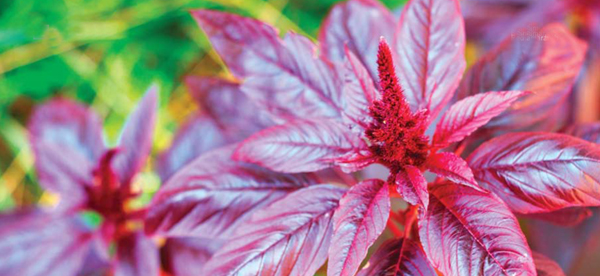Hot & Humid Monsoon Gardening

Red Amaranth
During a recent road trip I was fortunate enough to have the opportunity to visit an American landmark that I had wanted to visit for many years – the Mitchell Corn Palace of Mitchell, South Dakota. The exterior of the Corn Palace is adorned with decorative murals that are constructed almost entirely of corn kernels. It takes over 100 acres of plants to provide enough corn to complete the murals. Each year a new theme is selected for the murals and they are taken down and replaced, this year’s theme was “Remember When.”
It may seem odd to have a palace dedicated to and built from corn, but for a Southwestern gardener like me, a palace dedicated to corn seems very appropriate considering corn’s importance in our region – both historically and today.
Corn has been grown in the Americas for thousands of years as a staple food crop for the Native Americans that domesticated it. Today, when most people think of corn they picture a steaming sweet yellow cob that often accompanies meat and potatoes at summer barbecues. In all actuality this type of sweet corn is a relatively new discovery, botanically speaking. The majority of corn grown both historically and today is used as feed for livestock or as a base ingredient for any number of food and non-food products. It is estimated that it takes 25 corn plants per person per day to maintain the American way of life.
Here in the southwest, tribes such as the Tohono O’odham, Quechan, and Gila perfected varieties of dent, flint, pop and sweet corns that grow exceptionally well when planted along with the heavy monsoon rains that occur this time of year. Tohono O’odham 60 Day, Yuma Yellow and Gila Pima “A:al Hu:n” are just a few of the many varieties of corn that grow well when planted with our summer rains. Other varieties to consider are Golden Bantam 8 Row, Golden Bantam 12-Row and Hopi Blue.
Along with corn, a wide variety of edible crops have been domesticated to grow and thrive in the hot and humid conditions that are characteristic of the monsoon. The main benefit of growing native crops that are indigenous to our area is that they are already acclimated to our extreme weather conditions; however there are several added benefits. First among them is that many of our native crops are highly nutritious. Amaranth, for example, is often touted as the next super food for its high nutrient content. My favorite variety of amaranth is Hopi Red Dye for the color it brings to the summer garden, but you will also have success growing the varieties Mayo Grain and Alamos.
Another benefit of planting a monsoon garden of native crops is that they are often very different than what is commonly available at grocery stores and farmer’s markets. This variety will bring a little excitement to your culinary experiments. Tepary beans are highly nutritious and the most drought tolerant of any bean. Tests have shown that they can subsist without any external irrigation whatsoever. For gardeners in cooler parts of our region, the Bolita bean is a great substitute for the common pinto bean as they taste better, cook faster and have a creamier texture. Other crops to consider for your monsoon vegetable garden include cowpeas, okra and watermelon.
When planning for your monsoon garden keep in mind that although the crops discussed above generally thrive during this hot and humid season, they still need to be planted in such a way that that they are able to take advantage of short bursts of heavy rain. Planting in a sunken bed or basin is the traditional growing method for a monsoon garden. Designing your garden in this way will help to conserve as much rain water as possible. If possible, rain water should be directed from your roof or any other catchment to the garden where it will do the most good. Your garden will also benefit immensely if you incorporate other organic gardening principles such as intensive spacing, companion planting and mulching into your plans.
All of the seed varieties listed above can be found online at NativeSeeds.org or by visiting the Native Seed/SEARCH retail store at 3601 N. Campbell Ave. Brandon Merchant is the proprietor of Southwest Victory Gardens. Visit his website at SouthwestVictoryGardens.com.
Category: Community, FOOD & DRINK, Nature




